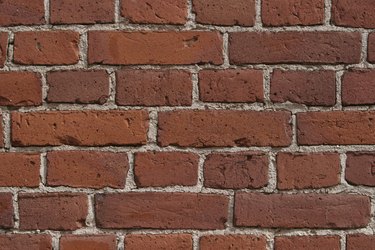
Exterior walls support the roof of a house and shield its interior. They must be strong enough to carry the weight of the roof and to resist the forces of wind and weather, but also should be attractive. Ideally they also should provide some insulation and be easy to maintain. Some exterior walls combine supportive strength and exterior appearance, but most types have a structural element and a cladding or covering for appearance.
Ten Types
Video of the Day
There are 10 basic types of exterior wall: poured concrete, masonry (brick or stone), stucco, synthetic or artificial stucco, wood (shingles, shakes or planks), metal (steel or aluminum), vinyl, asphalt shingles, tile (slate or clay) or fiber cement (planks or panels). Some exterior walls may be combinations, such as stucco installed over poured concrete or wood sheathing or corrugated aluminum fastened over wood framing.
Video of the Day
Wall Ratings
Exterior wall surfaces are rated by strength, both structural and resistance to damage, weather resistance, insulating value and maintenance. Only masonry, concrete or brick rates high on structural strength. All options rank generally good for weather-tightness but all rate poor in insulating value unless special insulation is added. Wood siding ranks highest in maintenance requirements, although maintenance of stucco and masonry will vary if those are painted. Cement fiber is low maintenance.
Moisture is the Enemy
All wood siding is subject to rot and moisture damage; wood also can crack or split. Masonry, including stucco, also can be subject to moisture damage which causes cracking or spalling (peeling of the surface). Vinyl and metal siding can be dented or loosened by hail or similar weather-related problems. Vinyl also can come loose at fastening points.
Wood and Brick Most Popular
Wood and brick are the most popular exterior wall siding options. Fiber cement is increasingly popular as an option to wood; it closely resembles wood (in some cases can be matched to existing wood siding) because it is durable, resists rot and insects and holds paint well. Most wood siding is tongue-and-groove material, overlapping clapboards or exterior plywood panels. Brick (and some stone) is typically installed as veneer, a single layer of bricks on a wood-sheathed wall.
Concrete Blocks
Concrete blocks are sometimes used as both structural and exterior finish walls. Concrete blocks frequently are overlaid with exterior stucco for a more decorative surface. Some "dry-stacked" concrete block walls are covered with a surface-bonding cement that provides structural strength and a more solid, attractive finish than a typical mortared block wall.